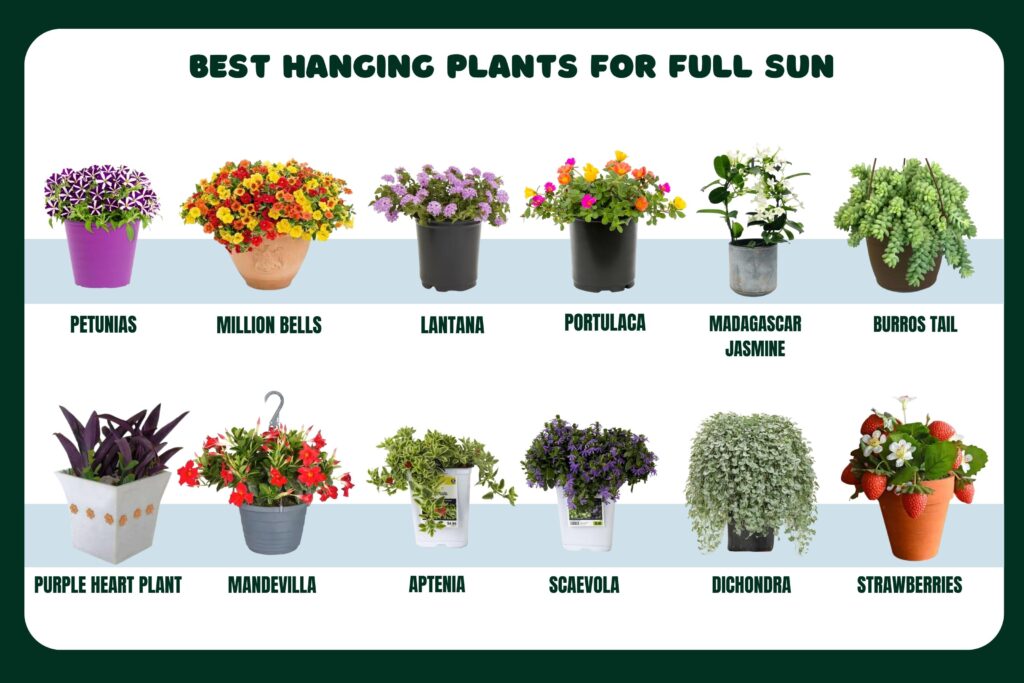
Are you tired of feeling like you’re in a desert when stepping out into your sunny outdoor space? Do you want to add life and vibrancy to your patio or balcony but are unsure which plants can withstand the blazing heat? Look no further, my fellow sun lovers! Hanging plants for full sun are here to save the day and add much-needed shade and style to your outdoor haven.
I used to love potting up hanging baskets to sell at the nursery, and after keeping them on the shelf to mature, you get to see them looking their best. In West Australia, we have scorching summers, so choosing the right plants for the baskets was vital. I’ve made a list of all the plants we planted in hanging baskets and how you can care for them- I can’t wait to share it with you!
Sit back, relax, and enjoy learning about these sun-loving hangers!
Petunias

Petunia is like the popular kids in school- everyone knows them, and they’re always the center of attention. Originally from South America, petunias come in various shapes and sizes with the wow factor.
Petunias grow to be anywhere from 6 inches to 2 feet tall and have a bush or trailing growth habit. They love to spread out and show off their colorful blooms- which, let’s face it, are like the fashionistas of the plant world!
Regarding requirements, Petunias prefer to be in full sun and well-draining soil. They need plenty of water to keep them hydrated, but make sure you don’t drown them. They also love a good fertilizer feeding to keep them blooming all season long.
There are plenty of Petunia varieties to choose from, like the Grandiflora, which produces large, showy flowers, or the Multiflora, which is more tolerant of heat and rain. And don’t forget the famous wave Petunias with their trailing growth habit that’s perfect for hanging baskets.
Million Bells
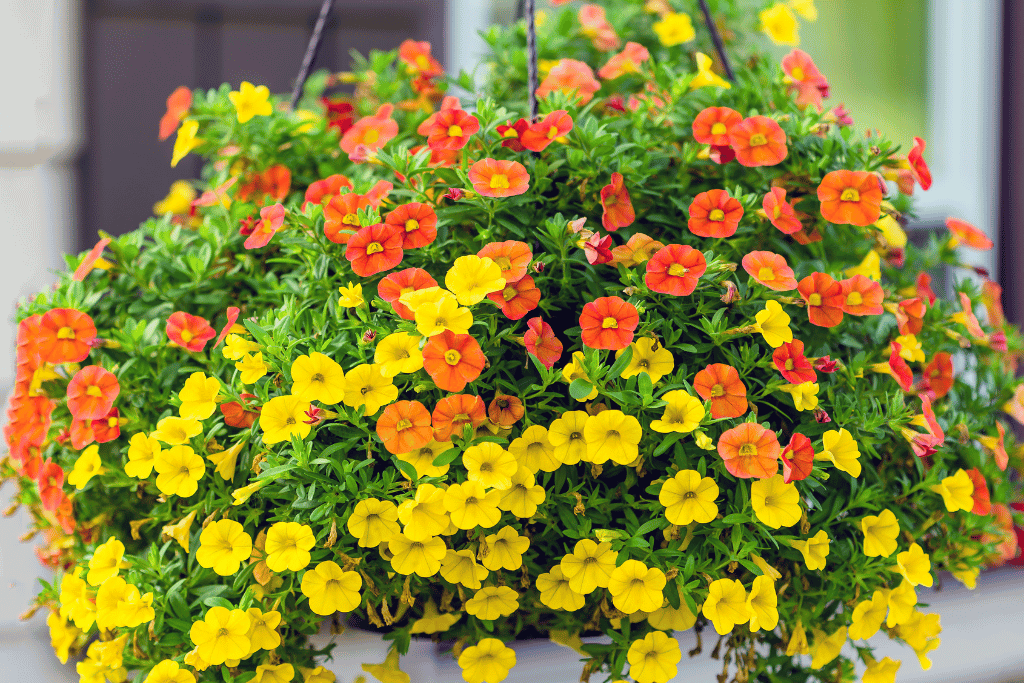
Next on the list is the Million Bells plant. Don’t let its name fool you- it has no resemblance to bells, but it sure is a beauty! This plant is a hybrid of Calibrachoa, native to South America, and comes in a vast range of vibrant colors, so you’re bound to find a color to fit your scheme.
Million Bells are compact trailing plants that grow about 6-12 inches tall and wide. They have a bushy growth habit that spills over the edges of the hanging basket, window box, or wall planter. Don’t let their size give you the wrong impression- they produce an abundance of blooms that are sure to impress.
These plants love the full sun, so give them a spot that gets plenty. They also prefer a well-drained soil; an all-purpose potting mix would work great. Because they love to bask in the sun, they build up a thirst, so remember to give them regular water and keep their soil moist.
You can give them a dose of fertilizer every few weeks to keep them looking fabulous. Use a balanced all-purpose fertilizer like 10-10-10 npk, and they will continue to do their thing.
If you’re out shopping for these plants, watch for the yellow-centered Lemon Slice, the Pink, and white ‘Starlight,’ and the deep purple ‘Cabaret.’ No matter your choice, they will all impact your outdoor area.
Lantana
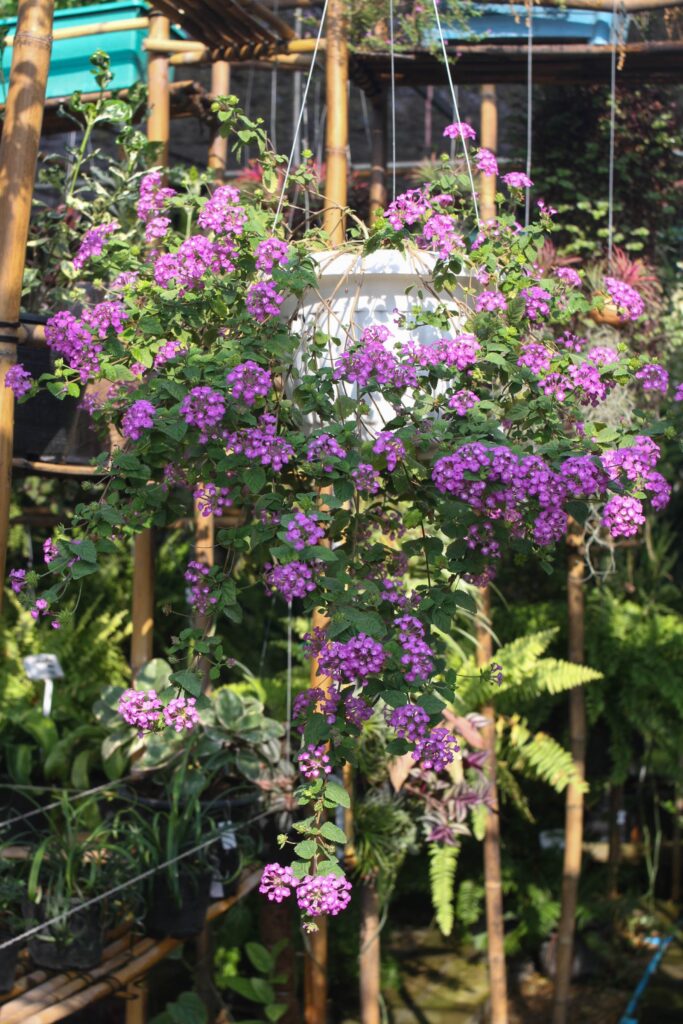
Lantana is like a breath of fresh air. It’s native to the tropical regions of the Americas and Africa, and it’s just as vibrant as you’d imagine.
Lantana can grow from 1 to 6 feet tall and has a bushy growth habit perfect for filling empty spaces. Because of this, you must keep them trimmed when planting them into a hanging basket. The colorful blooms on the lantana are like mini fireworks and are bursting with color.
When caring for the Lantana, it loves to be planted in well-drained soil and positioned in the full sun. It’s pretty drought-tolerant, so not a bad plant if you’re a forgetful waterer! Let the soil dry out between waterings and give it a dose of fertilizer every three weeks during the growing season, and it will thank you for it.
There are plenty of Lantana varieties, like Miss Huff with its bright orange blooms or the Dallas Red with its deep red flowers. And let’s not forget about the Silver Mound with its silvery green foliage that’s just as stunning as its blooms.
One thing to note with this plant is it is classed as an invasive weed species in some countries, so be mindful of where you plant it as it drops small berries and could potentially take over your garden! Over than that, Lantana is a lovely plant when it’s kept under control.
Portulaca
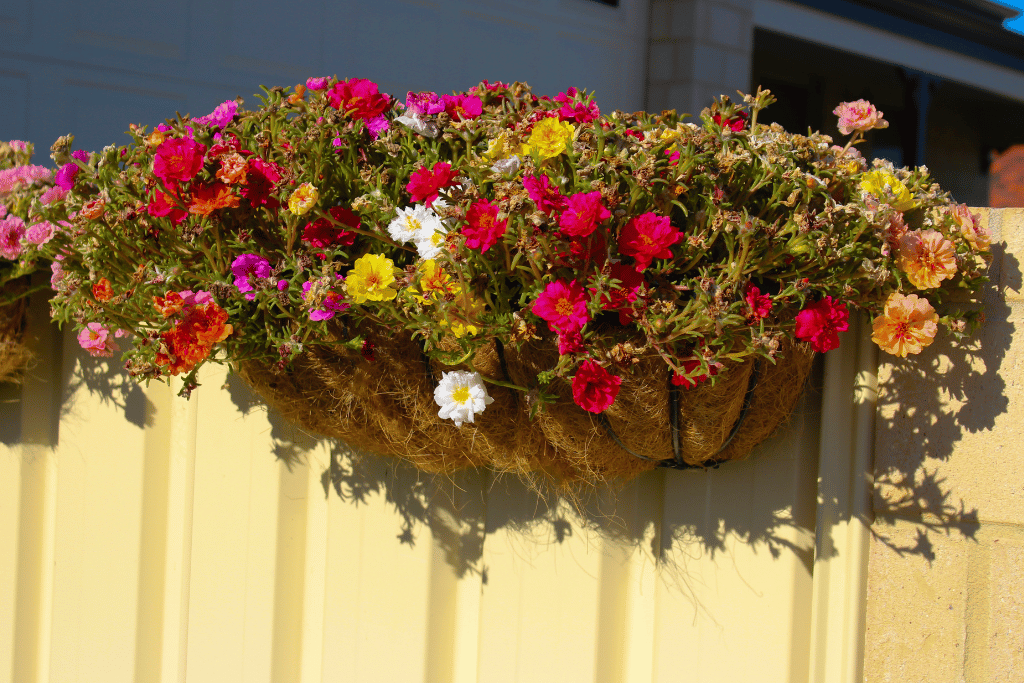
Portulaca is a small plant with a significant impact. Native to South America, it’s like the spunky little cousin of the succulent family. Portulaca grows only a few inches tall but has a spreading growth habit that makes it one of the best plants for hanging baskets.
Looking after the Portulaca is easy; it’s a low-maintenance plant that loves the full sun. Because of its succulent characteristic, it tolerates dry spells, so don’t worry if you miss a watering day or two!
Portulaca goes by a few different names, like purslane and Moss rose, but no matter what your call it, it’s like the little superhero of the garden. Its bright blooms come in various colors, from pink to yellow to orange, and it’s like the cherry on the top of any garden design.
Madagascar Jasmine

Madagascar Jasmine is like the exotic beauty queen of the plant world. It’s native to tropical areas of Asia and Africa and is known for its fragrant star-shaped white flowers that look like they belong to a fairy tale.
This plant can grow up to 6 feet tall and has a climbing growth habit, so when it’s in a hanging basket, the vines will trail down like strings of stars. Because of its staggering height, you must give it a trim occasionally.
When it comes to requirements, Madagascar Jasmine is a bit high maintenance; it needs full sun but can tolerate part shade. It does best in a rich, well-draining potting mix with extra organic matter. It’s essential to keep this diva’s soil consistently moist too; they don’t like to dry out too much.
If you’re out shopping for this one, you might come across names like Wax flower and Bridal wreath, but no matter what you call it, it’s still the star of the show!
My Madagascar Jasmine is hanging by my front door, and it gives off a sweet fragrance to anyone who comes around my house; it is a stunning plant to own.
Burros Tail
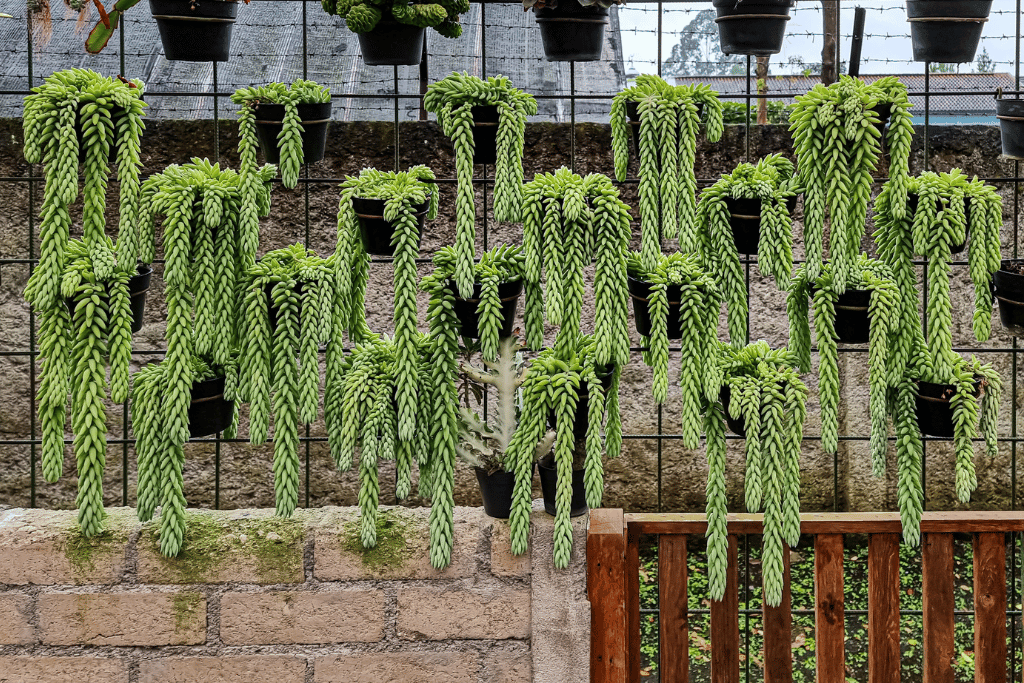
Burros tail is a laid-back succulent plant that is native to Mexico. It’s known for its long trailing stems that look like they belong on a beach somewhere.
This plant can grow up to 3 feet long and grows in a trailing fashion. Many gardeners opt for planting in hanging baskets or pots where the tail-looking branches dangle over the edge.
Burros tail is one of the least demanding plants and is happy to bask in the bright indirect sunlight. It thrives in well-draining soil and only really needs watering once a week. Other names this succulent plant goes by are the Donkey tail and Lamb’s tail.
One of the great things I love about this plant is how easy they are to propagate. You can cut off a stem and push it into the soil, and it will continue growing.
So, if you’re looking for a super low-maintenance plant and want to add a different texture to your plant collection, the Burros tail is the way to go.
Purple Heart Plant
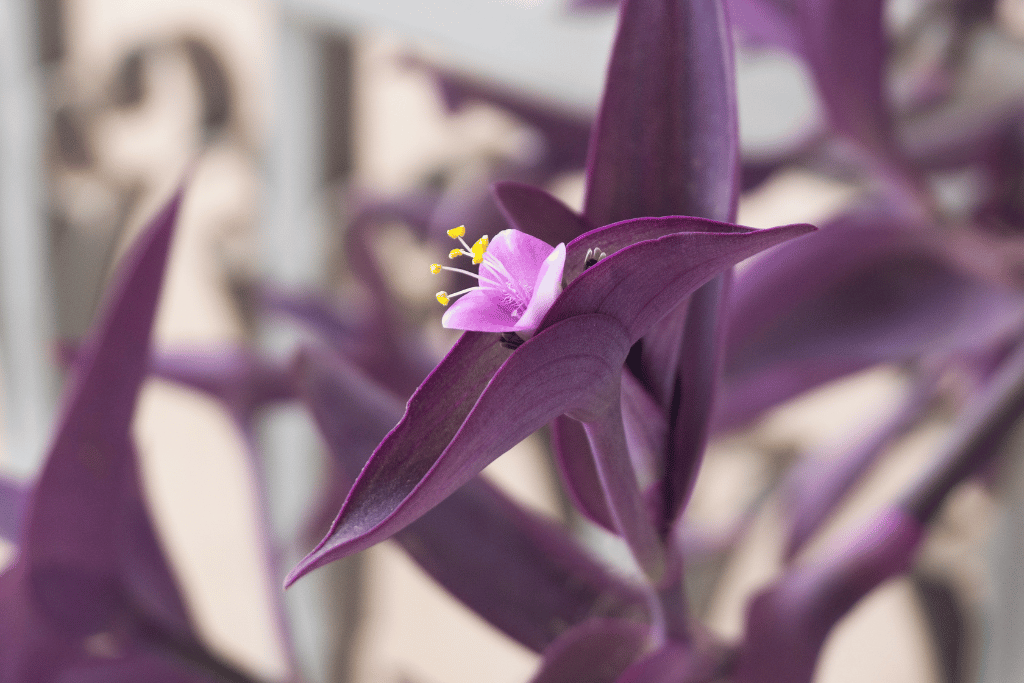
Purple plants always steal the show with their striking deep purple leaves; the Purple heart plant is no exception. It’s a native of Mexico and Central America and can grow up to a foot tall. Its trailing growth habit makes it one of the best outdoor hanging plants for full sun.
This tropical plant is a vigorous grower and blooms light pink star-shaped flowers. It’s an easy plant to grow, so if you’re a beginner gardener, you will have no trouble with it.
When taking care of the Purple Heart plant, make sure it’s in a position that receives bright direct sun for about 6 hours daily. Pot it into a well-draining potting mix with some added organic compost and keep it watered regularly. Because it’s a tropical native, it doesn’t like to dry out too much between watering.
The Purple Heart plant is also known as Purple Queen and Tradescantia pallida, so when you are at your local garden store next, keep a look out for this one and add it to your collection for some extra purple power!
Mandevilla

The Mandevilla is a perfect choice if you’re looking for a plant like a summer romance. It’s like the charmer from the tropics with its origins in South America and a name that sounds like it belongs in a romantic novel.
This plant can grow to a staggering 10 feet tall and has a climbing growth habit that makes it perfect for hanging baskets or even trellises. The Mandevilla is available in white, light pink, and deep wine-colored reds. Mandevilla isn’t the fussiest plant out there, but they require a lot of sunshine to thrive.
The trumpet-shaped blossoms will last a few days and can drop, so you may find that you’ll have to sweep them from your patio if it’s in a hanging basket. Don’t let this put you off though; they are lovely plants and add a touch of romance to the garden.
When potting the Mandevilla, use an all-purpose potting mix, and water it regularly to keep it happy. They also do well with a dose of fertilizer every three weeks during the growing season. You can use an all-purpose fertilizer on these with a ratio of 10-10-10 npk, and follow the instructions on the label.
Some other names it goes by are Dipladenia and Rock trumpet, so keep an eye out when you’re at your local nursery next.
Aptenia

Aptenia is a hardy coastal plant that can survive the harsh conditions of South Africa. They are among the most popular choices for landscapers and gardeners as they require little maintenance and grow quickly to cover a space. They have a trailing growth habit that you can use in hanging baskets.
The glossy, waxy stems and leaves of the Aptenia look beautiful when spilling over the pot’s edge. As one of the most laid-back plants around, it requires little interference on your part.
These plants can tolerate drought, extreme heat, salty air, and poor sandy soil conditions, and it doesn’t need much fertilizer to keep them happy and healthy. But if you give it a little TLC with a trim and regular watering, it will thank you.
When in bloom, the Aptenia showcases small, vibrant pink star-like flowers that attract pollinators like bees, butterflies, and birds.
If you want to add this to your collection, look for Baby Sunrose and Heartleaf Ice plant names. If you’re looking for a true survivor to add a splash of color to your full-sun patio, then the aptenia is an excellent choice.
I have aptenia trailing around the edge of my garden; it’s a great plant to have and is super easy to fill gaps with. You can multiply this plant by cutting off a stem and pushing it into the soil where you want it to grow next. Think of it like an investment in your plant collection!
Scaevola

The Scaevola is a true-blue Aussie in the plant world. It has a growth habit like a laid-back beach bum and resilience like a true survivor. Scaevola is a low-growing plant that can reach a foot in height and has a spreading growth habit that makes it perfect for hanging baskets.
When in bloom, the Scaevola bursts with unique fan-shaped flowers in various colors like blue, pink, white, and purple. These make a significant impact in a hanging basket and can splay out quite wide, so leave plenty of room for it.
The requirements of the Scaevola are pretty simple. Because they are coastal plants, they can take infrequent watering and various soil conditions. They love to bask in the full sun on a hot summer’s day and make a great attraction for bees and butterflies.
If you want to give your Scaevola a little love, you can give it a regular watering routine and the occasional fertilizer to help it thrive. You don’t have to be fully neglectful!
When shopping for one of these, you might see it called Australian Fan Flower or Fairy Fan Flower. Usually, this plant is sold as a ground cover, and landscapers love it for its fast-growing nature, but when it’s in a hanging basket, it adopts a new look with a touch of elegance.
This plant is somewhat underrated and should be planted more!
Dichondra

Dichondra is one of my favorite plants; it’s a real gem! It’s native to North America and is commonly known as silver falls due to its cascading silver foliage. It’s a low-growing perennial herb that thrives in full sun or part shade.
The fan-shaped silver foliage is fast-growing and can easily create a statement in no time. It’s a tough plant despite its glamorous looks and can tolerate minimal dry spells when fully matured. The Dichondra grows up to 4-6 inches tall, with its trailing stems reaching 4 feet, making it perfect for hanging baskets.
This shimmery plant is relatively easy to care for; it just needs moist but not soggy soil and a little fertilizer. Remember that the Dichondra is not a fan of cold winters, so if you’re in an area where the temperatures drop, you may need to relocate it inside the house.
If you’re feeling adventurous, you can even use it in cooking! It’s said to have a tangy flavor that adds a unique twist to salads and other dishes.
I’ve been lucky enough to own a Dichondra silver falls for the past three years, and it is a real talking point when my visitors come around. I hope you take the plunge and add it to your collection.
Strawberries

Yes! Strawberries! These are fantastic for hanging baskets, and almost everyone loves them!
If you are looking for the best hanging plant for full sun, look no further. Why not have juicy red fruit dangling down from your porch on a hot summer’s day? These plump red berries are not only delicious but are easy to grow.
Originally from Europe, Strawberries are a member of the rose family and can be traced back to the 18th century. They are known for their heart shape and bright red color and come in many different varieties.
Strawberries are low-growing and have a spreading growth habit making them ideal for planting in containers and hanging baskets. They prefer well-drained soil rich in organic matter and need plenty of water, especially during summer.
To ensure your Strawberry plants produce juicy and sweet berries, fertilize them regularly and prune them back when needed. Watch out for pests, like slugs and birds that feast on them.
Whether you enjoy them fresh, in pies, or blended into a smoothie growing your own strawbs can be a fun and rewarding experience.
Choosing the Best Outdoor Hanging Plants for Full Sun

So, there you have the best hanging plants for full sun. These plants range from easy low- maintenance plants to slightly demanding types.
Some critical factors to consider when deciding are how much time you have to care for them, the amount of space they will take up, and the look you want to go for. There’s no point having a thirsty plant if you are only home to water it a few days per week.
On the other hand, if you’re like me and find great satisfaction in fiddling with plants and flowers, why not take on the challenge of Jasmine or Mandevilla?
Whichever plant you decide to go for, I’m sure your neighbors will be green with envy!




Pingback: Hanging Basket Plants Full Sun - Back Gardener